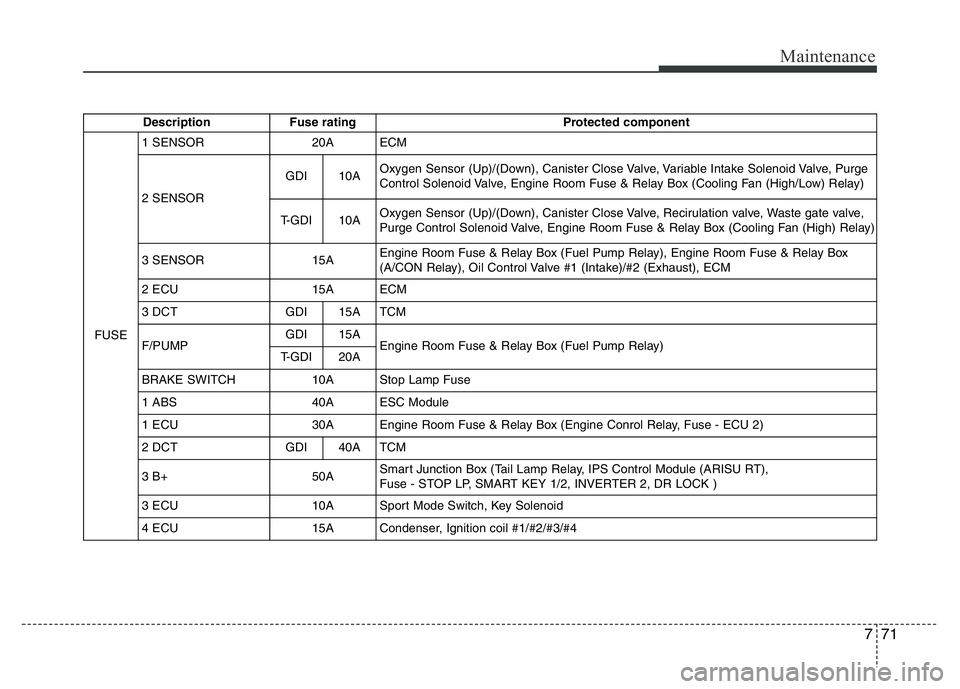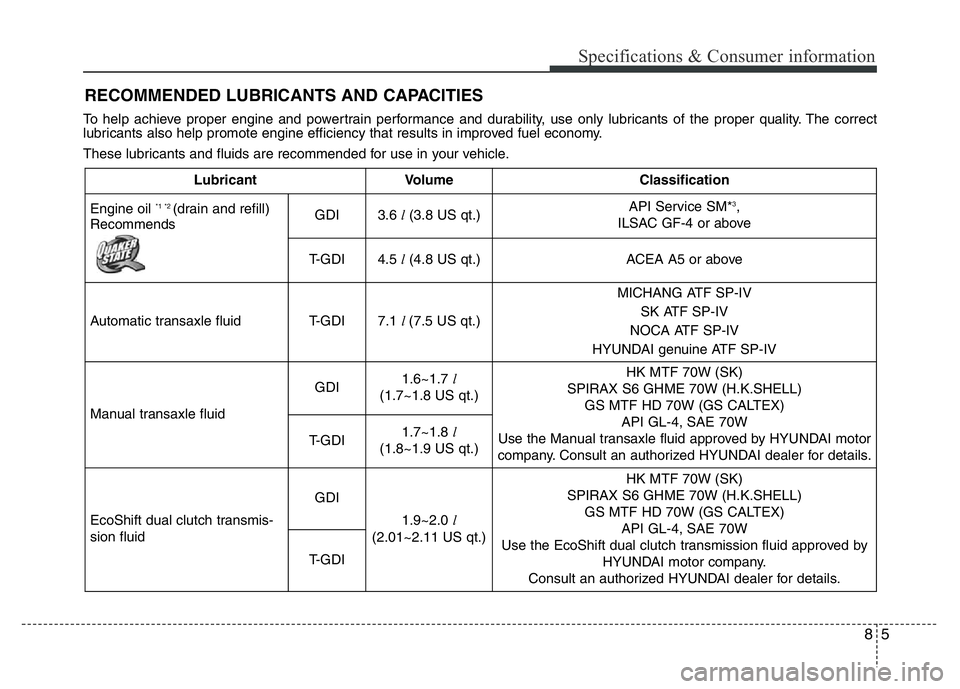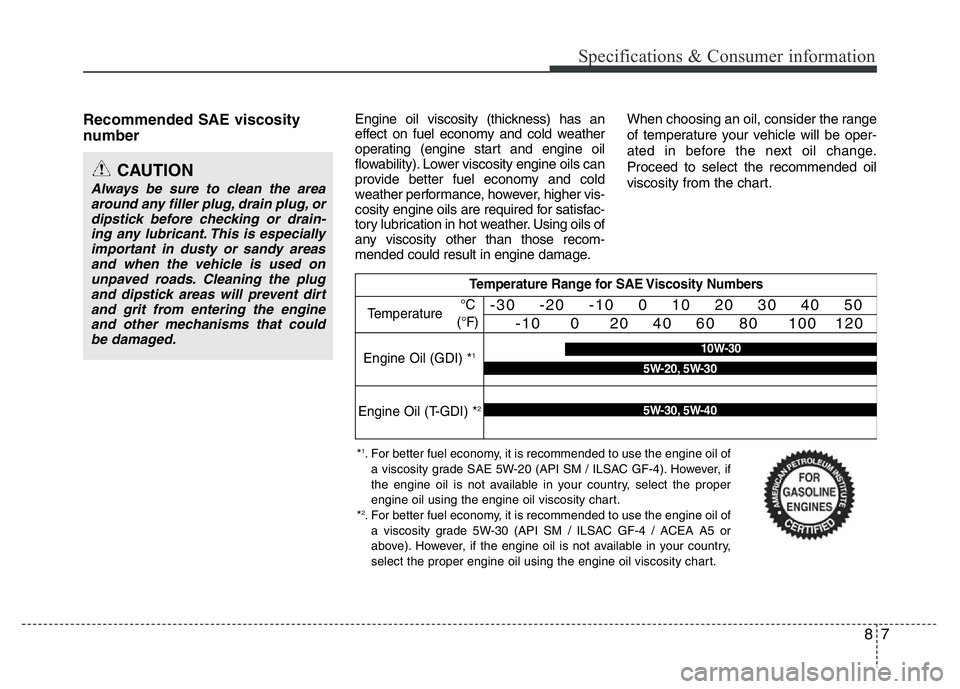Page 357 of 406

747
Maintenance
Battery recharging
Your vehicle has a maintenance-free,
calcium-based battery.
If the battery becomes discharged in a
short time (because, for example the
headlights or interior lights were left on
while vehicle was not in use) jump start
the vehicle from another battery and run
the engine at least 20 minutes at idle
before driving. Do not turn off the engine
for 30 minutes total of idle and/or driving
as the battery may not have sufficient
recharge to start.
CAUTION
• When the vehicle is not used for a
long time in the low tempera-
tures, remove the battery and
stores it indoors.
• Always charge the battery fully to
prevent the battery case from
being damaged in low tempera-
tures.
• If you use unauthorized electric
devices, the battery may be dis-
charged. Never use unauthorized
devices.
(Continued)
• The electrical ignition system
works with high voltage. Never
touch these components with the
engine running or the ignition
switched on.
Failure to follow the above warn-
ings can result in serious bodily
injury or death.WARNING- Recharging
battery
When recharging the battery,
observe the following precautions:
• The battery must be removed
from the vehicle and placed in an
area with good ventilation.
• Do not allow cigarettes, sparks,
or flame near the battery.
• Watch the battery during charg-
ing, and stop or reduce the charg-
ing rate if the battery cells begin
gassing (boiling) violently or if
the temperature of the electrolyte
of any cell exceeds 49°C (120°F).
• Wear eye protection when check-
ing the battery during charging.
• Disconnect the battery charger in
the following order.
1. Turn off the battery charger main
switch.
2. Unhook the negative clamp from
the negative battery terminal.
3. Unhook the positive clamp from
the positive battery terminal.
Page 372 of 406

Maintenance
62 7
FUSES
A vehicle’s electrical system is protected
from electrical overload damage by
fuses.
This vehicle has 2 fuse panels, one locat-
ed in the driver’s side panel bolster, the
other in the engine compartment.
If any of your vehicle’s lights, acces-
sories, or controls do not work, check the
appropriate circuit fuse. If a fuse has
blown, the element inside the fuse will be
melted.
If the electrical system does not work,
first check the driver’s side fuse panel.
Before replacing a blown fuse, discon-
nect the negative battery cable.
Always replace a blown fuse with one of
the same rating.
If the replacement fuse blows, this indi-
cates an electrical problem. Avoid using
the system involved and immediately
consult an authorized HYUNDAI dealer.
Three kinds of fuses are used: blade type
for lower amperage rating, cartridge type,
and multi fuse for higher amperage rat-
ings.✽NOTICE
The actual fuse/relay panel label may
differ from equipped items.
WARNING - Fuse
replacement
• Never replace a fuse with any-
thing but another fuse of the
same rating.
• A higher capacity fuse could
cause damage and possibly a fire.
• Never install a wire or aluminum
foil instead of the proper fuse -
even as a temporary repair. It may
cause extensive wiring damage
and a possible fire.
CAUTION
Do not use a screwdriver or any
other metal object to remove fuses
because it may cause a short circuit
and damage the system.
OBK079042 NormalNormal Blade type
Cartridge type
Multi fuseBlown
Blown
Normal Blown
Page 381 of 406

771
Maintenance
Description Fuse rating Protected component
FUSE1 SENSOR 20A ECM
2 SENSORGDI 10AOxygen Sensor (Up)/(Down), Canister Close Valve, Variable Intake Solenoid Valve, Purge
Control Solenoid Valve, Engine Room Fuse & Relay Box (Cooling Fan (High/Low) Relay)
T-GDI 10AOxygen Sensor (Up)/(Down), Canister Close Valve, Recirulation valve, Waste gate valve,
Purge Control Solenoid Valve, Engine Room Fuse & Relay Box (Cooling Fan (High) Relay)
3 SENSOR 15AEngine Room Fuse & Relay Box (Fuel Pump Relay), Engine Room Fuse & Relay Box
(A/CON Relay), Oil Control Valve #1 (Intake)/#2 (Exhaust), ECM
2 ECU 15A ECM
3 DCT GDI 15A TCM
F/PUMPGDI 15A
Engine Room Fuse & Relay Box (Fuel Pump Relay)
T-GDI 20A
BRAKE SWITCH 10A Stop Lamp Fuse
1 ABS 40A ESC Module
1 ECU 30A Engine Room Fuse & Relay Box (Engine Conrol Relay, Fuse - ECU 2)
2 DCT GDI 40A TCM
3 B+ 50ASmart Junction Box (Tail Lamp Relay, IPS Control Module (ARISU RT),
Fuse - STOP LP, SMART KEY 1/2, INVERTER 2, DR LOCK )
3 ECU 10A Sport Mode Switch, Key Solenoid
4 ECU 15A Condenser, Ignition coil #1/#2/#3/#4
Page 402 of 406

85
Specifications & Consumer information
RECOMMENDED LUBRICANTS AND CAPACITIES
To help achieve proper engine and powertrain performance and durability, use only lubricants of the proper quality. The correct
lubricants also help promote engine efficiency that results in improved fuel economy.
These lubricants and fluids are recommended for use in your vehicle.
LubricantVolumeClassification
Engine oil *1 *2 (drain and refill)
RecommendsGDI3.6 l(3.8 US qt.)API Service SM*3,
ILSAC GF-4 or above
T-GDI4.5 l(4.8 US qt.)ACEA A5 or above
Automatic transaxle fluidT-GDI7.1l(7.5 US qt.)
MICHANG ATF SP-IV
SK ATF SP-IV
NOCA ATF SP-IV
HYUNDAI genuine ATF SP-IV
Manual transaxle fluid
GDI1.6~1.7 l
(1.7~1.8 US qt.)HK MTF 70W (SK)
SPIRAX S6 GHME 70W (H.K.SHELL)
GS MTF HD 70W (GS CALTEX)
API GL-4, SAE 70W
Use the Manual transaxle fluid approved by HYUNDAI motor
company. Consult an authorized HYUNDAI dealer for details.
T-GDI1.7~1.8 l
(1.8~1.9 US qt.)
EcoShift dual clutch transmis-
sion fluid
GDI
1.9~2.0 l
(2.01~2.11 US qt.)
HK MTF 70W (SK)
SPIRAX S6 GHME 70W (H.K.SHELL)
GS MTF HD 70W (GS CALTEX)
API GL-4, SAE 70W
Use the EcoShift dual clutch transmission fluid approved by
HYUNDAI motor company.
Consult an authorized HYUNDAI dealer for details.
T-GDI
Page 403 of 406
Specifications & Consumer information
6 8
*1Refer to the recommended SAE viscosity numbers on the next page.
*2Engine oils labeled Energy Conserving Oil are now available. Along with other additional benefits, they contribute to fuel econ-
omy by reducing the amount of fuel necessary to overcome engine friction. Often, these improvements are difficult to measure
in everyday driving, but in a year’s time, they can offer significant cost and energy savings.
*
3If the API service SM engine oil is not available in your country, you may substitute API service SL.
LubricantVolumeClassification
Coolant
Automatic transaxle5.2 l(5.5 US qt.)Mixture of antifreeze and water
(Ethylene glycol base coolant for aluminum radiator)Manual Transaxle5.0 l(5.28 US qt.)Ecoshift dual clutch transmission
Brake/clutch fluid0.7~0.8 l
(0.7~0.8 US qt.)FMVSS116 DOT-3 or DOT-4
Fuel50 l(13.2 US gal.)Unleaded gasoline
Page 404 of 406

87
Specifications & Consumer information
Recommended SAE viscosity
number Engine oil viscosity (thickness) has an
effect on fuel economy and cold weather
operating (engine start and engine oil
flowability). Lower viscosity engine oils can
provide better fuel economy and cold
weather performance, however, higher vis-
cosity engine oils are required for satisfac-
tory lubrication in hot weather. Using oils of
any viscosity other than those recom-
mended could result in engine damage.When choosing an oil, consider the range
of temperature your vehicle will be oper-
ated in before the next oil change.
Proceed to select the recommended oil
viscosity from the chart.
CAUTION
Always be sure to clean the area
around any filler plug, drain plug, or
dipstick before checking or drain-
ing any lubricant. This is especially
important in dusty or sandy areas
and when the vehicle is used on
unpaved roads. Cleaning the plug
and dipstick areas will prevent dirt
and grit from entering the engine
and other mechanisms that could
be damaged.
Temperature Range for SAE Viscosity Numbers
Temperature -30 -20 -10 0 10 20 30 40 50
-10 0 20 40 60 80 100 120
Engine Oil (GDI) *1
Engine Oil (T-GDI) *2
10W-30
5W-20, 5W-30
5W-30, 5W-40
°C
(°F)
*1. For better fuel economy, it is recommended to use the engine oil of
a viscosity grade SAE 5W-20 (API SM / ILSAC GF-4). However, if
the engine oil is not available in your country, select the proper
engine oil using the engine oil viscosity chart.
*
2. For better fuel economy, it is recommended to use the engine oil of
a viscosity grade 5W-30 (API SM / ILSAC GF-4 / ACEA A5 or
above). However, if the engine oil is not available in your country,
select the proper engine oil using the engine oil viscosity chart.